New Analysis Method Detects Pathogens in Blood Faster and More
February 24, 2024
Source: drugdu
 284
284

Globally, an alarming one in every five deaths is attributed to complications related to sepsis, with children accounting for 41% of these fatalities. The urgency in detecting sepsis is paramount since the risk of mortality increases by 4% for each hour the infection remains undiagnosed or treated incorrectly. Common practice involves administering antibiotics to sepsis patients while waiting for blood culture results, which can contribute to antibiotic resistance. Ineffectively treating sepsis can be detrimental, as up to 30% of patients receive incorrect treatments, further elevating their risk of death. The critical nature of timely and accurate diagnosis in sepsis cases is underscored by the fact that the mortality risk escalates by 4% every hour the infection is not properly identified or treated. Now, a new analysis technique offers quicker and more precise pathogen detection in blood samples compared to traditional blood cultures, which are the standard in infection diagnosis.
The new method, called digital DNA melting analysis, has been developed by researchers at UC San Diego (La Jolla, CA, USA) and is capable of delivering results in less than six hours. This marks a significant improvement over the typical 15 hours to several days required by culture methods, depending on the pathogen involved. The process utilizes universal digital high-resolution DNA melting, involving heating DNA until it separates. Each DNA sequence reveals a unique signature during the melting process. By imaging and analyzing this process, machine learning algorithms can discern the types of DNA in the samples and identify pathogens. This method not only outpaces blood cultures in terms of speed but also has a substantially lower risk of generating false positives compared to other emerging DNA detection technologies, such as Next Generation Sequencing.
The research began with one milliliter of blood from each of 17 patients in a preliminary clinical study. These samples were collected concurrently with those for blood cultures from infants and toddlers. The researchers honed the DNA isolation process and machine learning techniques to minimize or eliminate interference from human DNA in contrast to pathogen DNA in the samples. They refined a machine learning algorithm to accurately distinguish between the melting curves of pathogens and background noise. This algorithm correlates the observed curves with a database of known DNA melt curves. Moreover, it can identify curves produced by organisms not in this database, which is particularly useful in detecting rare or emerging pathogens in a sample.
The results from this method were not only consistent with those obtained from blood cultures of the same samples, but they also did not yield any false positives. This contrasts with other tests based on nucleic acid amplification and next-generation DNA sequencing databases, which tend to amplify all present DNA, leading to false positives. Contamination from various sources such as the environment, test tubes, reagents, and skin can often lead to challenges in interpreting test results. This new method detected pathogens 7.5 hours to approximately 3 days faster than conventional blood cultures. Additionally, it provides more than just a binary positive or negative outcome; it quantifies the extent of pathogen presence in the samples. Future plans include conducting a more extensive clinical study and extending the methodology to adult patients.
“This is the first time this method has been tested on whole blood from patients suspected of having sepsis. So this study is a more realistic preview of how the technology could perform in real clinical scenarios,” said Stephanie Fraley, a professor at the UC San Diego. “We want to give doctors the ability to treat their patients based not on aggregate data, but with precise, accurate individual data, enabling truly personalized medicine.”
Source:
https://www.labmedica.com/microbiology/articles/294800341/new-analysis-method-detects-pathogens-in-blood-faster-and-more-accurately-by-melting-dna.html
Read more on
- Multiple batches of quadrivalent influenza virus split vaccine have been sub-packaged and submitted for lot release approval; expected to be released to the market soon after approval December 12, 2025
- Ab&B Bio-Tech CO., LTD. JS Lyophilized Human Rabies Vaccine Initiates Phase III Clinical Trials December 12, 2025
- The ‘Sweetest’ HPV Vaccine Market is Gone | Haibin Interview December 12, 2025
- InnoCare Pharma announced that its first independently developed next-generation TRK inhibitor, zoletrazinib, has been approved for marketing in China December 12, 2025
- Is PD-1/VEGF dual antibody + ADC becoming the standard configuration? December 12, 2025
your submission has already been received.
OK
Subscribe
Please enter a valid Email address!
Submit
The most relevant industry news & insight will be sent to you every two weeks.



